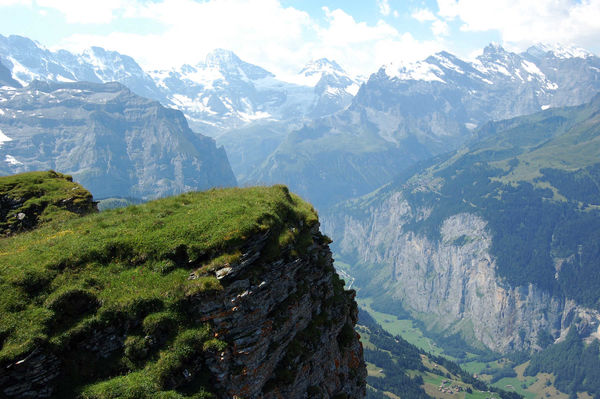Flying with Fritz in Switzerland
By Rick Steves
Swiss people are expert at living with nature. Like people who live along the coast have telescopes to watch the ships, Swiss mountain dwellers have telescopes on their back decks to watch the mountain face across the valley — they know their mountains intimately…where the ibex graze, where little avalanches tumble, and where the rock climbers bivouac.
Their land, long a mountain fortress, is now a "playground for big boys," as my friend Fritz once put it. Fritz, a dynamo who had run my favorite little hotel in Interlaken, had recently broken his collarbone when I arrived for one particularly memorable visit. For the first time, I was able to keep up with him. Fritz was the type who'd climb a mountain on his bike just to see the sunset. I'm forever thankful to Fritz (who was roughly my age, but died in 2011) for alpine mountain-biking my son Andy into the ground — and then taking him "flying."
Paragliding was Fritz's passion, and he ran a tandem paragliding side business called "Flying with Fritz." He was forever nagging me to "go flying." Andy still talks about his exhausting and exhilarating day riding and flying with Fritz.
As a hotelier, Fritz was tuned into the phenomenon of Indians coming to the Alps in droves. Most, he'd noticed, want to see mountain scenes made famous in Indian movies. Because of tension between Hindus and Muslims, India's mountainous Kashmir region had become too dangerous for movie production. As a result, many romantic Indian movies are filmed in Swiss mountain wonderlands, where lovers swoon with maximum melodrama. And that's why, in the Berner Oberland's Jungfraujoch train station, 11,000 feet above sea level, there's a restaurant called "Bollywood."
I was with Fritz when a freak hailstorm pulverized Interlaken. It had been really hot. Locals — like squirrels before a storm — had sensed it and were nervous. Something big was clearly coming. It got dark. Then bam — it was like a typhoon in the Alps. I parked my bike just in time to take refuge in Fritz's hotel.
Standing on my balcony, Fritz and I watched as car roofs were blanketed in dents and flower gardens hammered into pulp. The road became a river of flowing hail balls, leaves, and flower petals. To people living so close to the sky up here in the Swiss Alps, today's strange and changing weather is a maddening reality.
The next morning Fritz and I went on a hike. We rode the lift to Männlichen, high on the ridge above the valleys just beyond Interlaken, and stepped off and into a visual symphony: Before us towered the mighty Eiger, Mönch, and Jungfrau — for me, the most breathtaking alpine panorama anywhere. Fritz, who had worked at the mountaintop restaurant at Männlichen as a kid, talked of the changes here over the previous decade. As we walked past a glacial pond, he recalled how it had long been ringed by hundreds of singing frogs. Now there were none.
We studied a new ski lift then being built. Before, constructing a new lift just meant building a few towers. Nowadays, a swath is cut right up the mountain as each lift is plumbed with snow-making gear. The big water pipes that stuck out of the concrete foundations seemed to trumpet a new age. Fritz lamented that Swiss ski resorts could no longer make do without manmade snow.
From my pocket I pulled out a special postcard Fritz had given me. Wiggling it, I saw the glacier come and go. The valley in 1907…filled with ice. The same valley in 2007…dry with a shrunken glacier hanging like a panting dog's tongue over the top of the valley high in the distance.
Gazing up at the north face of the Eiger, Fritz told me of speed climbers who'd leave Interlaken to catch the early mountain train, scale this Everest of rock faces, and somehow make it back to Interlaken for a late-afternoon business meeting. "But as the permafrost thaws, there are more falling rocks," Fritz continued. "Mountain guides are now abandoning once-standard ascents that are no longer safe."
While travelers flock to Switzerland to ride the lifts, walk the dizzying ridges, and hungrily dip their bread into pots of bubbling cheese, it seems to me that it's the Swiss themselves who get the most joy out of their mountains. They know the story behind every peak, the flower behind every rock, the natural treasure that is their breathtaking land — and are acutely attuned to climate change, the slow-moving tragedy that threatens their alpine paradise.

